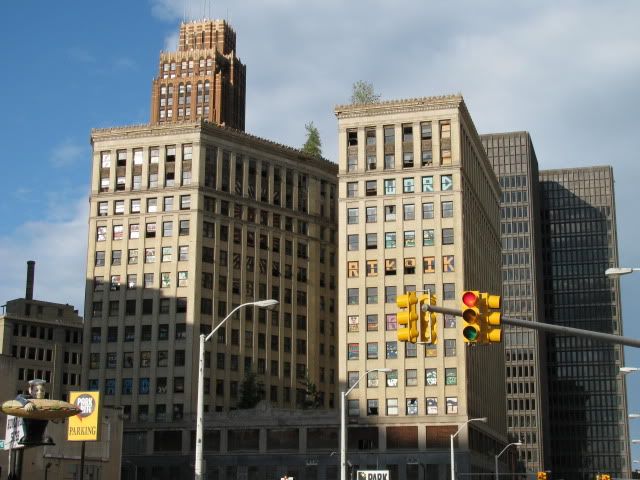
The V-Shaped Lafayette Building as seen from the roof of the Cadillac Hotel in 2003. Photo courtesy of DetroitYES.com
Currently under demolition, The Lafayette Building is the latest in a line of downtown buildings to face the wrecking ball after a debate on the merits of saving or razing older buildings. Detroiters have come to embrace its outdated landmarks that have been transformed by home-grown artists.
On the morning of June 25, 2009 the city's Downtown Development Authority voted unanimously to tear down the 1923 Lafayette Building, which has been empty for more than a decade. Detroit-based demolition company, Adamo was contracted for the project and according to Faded Detroit, was awarded $1,445,888.
The 14-story Italian Renaissance skyscraper, designed by C. Howard Crane, was once home to the Michigan Supreme Court and the state Tax Tribunal, among other offices.
Ashley Nanco, in Preservation Magazine quotes Karen Nagher of Preservation Wayne, Detroit's largest and oldest preservation organization as saying, "Detroit has some of the most fabulous resources in its downtown area. It's really dense with them. [The Lafayette Building] was so cutting-edge for the '20s." Nanco goes on further to state that earlier this year, the Detroit Economic Growth Corp. requested bids for the complete demolition of the building, which were due on April 2. That day, former Detroit mayor Kenneth Cockrel Jr. ceased demolition due to a petition that 815 people signed, urging him to save the city-owned building.
The Lafayette Building, on Lafayette Boulevard at Shelby just west of Woodward Avenue. Courtesy of The Detroit News
Detroit's city council, however quickly turned down local landmark designation for the Lafayette Building, a designation that would have delayed its demolition again.After reported years of mismanagement and changing ownership, the Lafayette Building closed in 1997. A fence has been put around the building to protect passersby from the crumbling slate facade additions added in the late 1960s. After which plant life sprout from the roof, and windows can be seen as either shattered or covered with graffiti. Some even describe the remains as, "a pop-art treat every time you walk down Lafayette Boulevard".
In 2005, the National Trust for Historic Preservation named the historic buildings of downtown Detroit to its list of America's 11 Most Endangered Historic Places but neglect to include the facts about Detroit artists who have added colors of paint as well as culture to this building. During the Superbowl the windows were scrubbed clean but still held reminiscence of this cities spirit.
The building is said to be not properly stabilized because the roof was left unprotected; a water tank left filled with water rusted through and ruptured, dropping a lot of water into the building. But some say this doesn't mean the building is irretrievable. Talks of the lot remaining empty until purchased as well as it becoming a park.
There has also been expressed concern for the two famous Detroit restaurants American Coney Island and Lafayette Coney Island, both family owned and operated since 1917. Both neighbors have been popular for decades.
Although, experts have concluded that the building can be restored, with historic tax credits, making it less expensive to rehabilitate than to develop an empty lot, the city is at a crossroads. Detroit's leaders can continue their demolition campaign, or they can work with developers and preservationists to breathe new life into old buildings and save the history of one of America's great cities.


No comments:
Post a Comment
Thank you for your comments! Your email address will not be shown or shared!
Due to overwhelming spam comments, this comment forum will now be moderated. No more "anonymous" comments will be allowed.